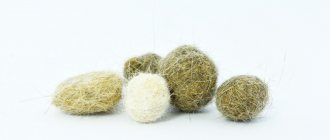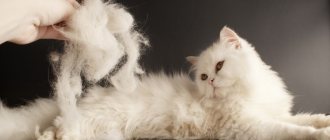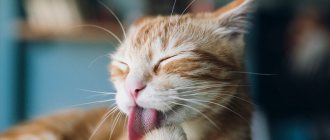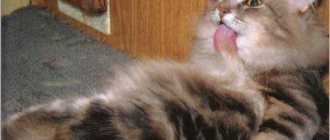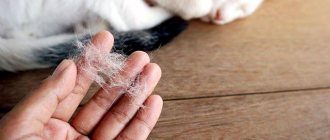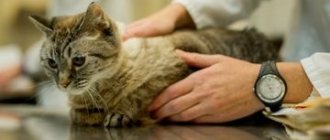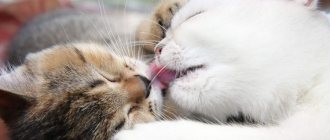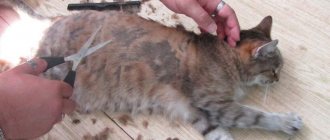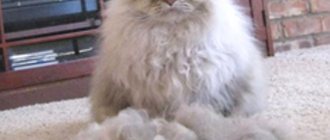Any cat owner would like their pet's coat to always look healthy and shiny. If a cat's fur falls out in clumps, the owner begins to worry. Although some hair loss due to shedding is a natural process, too much hair loss can be a symptom of a medical condition. Next, you can learn about the causes of hair loss in cats, how to treat this problem and how to distinguish it from regular shedding.
A cat's health can be determined by its fur.
Why does hair loss occur in cats?
Hair loss in cats is a fairly common problem. The reason why a cat's fur falls out in clumps and bald patches form may be a disruption in the body's functioning or the presence of diseases.
Natural causes of hair loss in clumps
Causes of hair loss in cats can be natural factors. They depend on age, time of year, quality of diet, stress level, and physiological changes.
Shedding. Seasonal molting is common to many animals. Cats are no exception. When shedding, only dead hair falls out and healthy hair grows after it. But in this case, bald spots should not form, the animal should look healthy and active.
Poor nutrition . Hair loss in cats is often caused by a lack of B vitamins. This often affects pets that are fed human food and cheap food. If a cat is given salty, fatty, spicy food, or a lot of whole milk, then the hair becomes dull and begins to fall out. This becomes especially noticeable on the neck, back and tail. The affected areas of the skin are very itchy, inflamed and flaky. Poor nutrition can cause not only hair loss, but also allergies and severe diseases of the gastrointestinal tract.
Kittens especially suffer from malnutrition. A lack of vitamins leads not only to excessive shedding, but also to rickets and the development of other pathologies.
Kittens may experience hair loss due to poor nutrition.
Stress . Cats have a very delicate nervous system. Any stress, for example, the departure of the owner, a change of environment, a long stay in the house of guests that the cat did not like, can provoke excessive hair loss, even complete baldness. The cat's health deteriorates, activity decreases, and it may refuse its usual food.
Licking is an important way to keep your cat's skin clean and healthy. However, excessive licking can lead to hair loss and other unpleasant consequences.
If a cat constantly licks the same area, eventually a bald spot will appear there and the condition of the fur in that area will deteriorate.
Excessive licking may be a sign of behavioral problems. She may lick herself to calm herself down. Boredom may also be the cause - if the environment does not stimulate play activity, the cat begins to lick itself more than necessary.
Excessive licking can lead to hair loss
Pregnancy, feeding kittens . Hormonal changes and lack of vitamins in pregnant and lactating cats are manifested by baldness around the nipples. During this period, it is especially important to maintain a balanced diet and add vitamins that will help maintain the health of both the mother cat and her kittens.
Old age . Older pets often develop bald spots in the area of the muzzle and ears, and long hairs remain in clumps. There is nothing dangerous in this, but it is worth remembering the increased risk of developing various diseases in such cats.
Skin diseases and causes of unnatural hair loss in clumps
Unnatural causes of hair loss are often accompanied by additional negative symptoms. Itching and crust formation in places where scratching, bleeding, and ulcers on the cat’s body should not be ignored by the owner.
Ringworm is one of the most common causes of hair loss in cats. This fungal infection is highly contagious and often occurs in cats or kittens kept in groups. The fungus that causes this disease is transmitted through contact with infected animals and objects. It remains viable for several months. The fungus penetrates the skin at the sites of bites, scratches and other injuries, affecting the surface layer of the skin and hair.
Ringworm symptoms manifest in different ways. Most likely, it will be noticeable that the cat has hair coming out in irregular or rounded areas. The skin in such areas may become red and peel. The coat may become brittle and look different than usual.
Ringworm in a cat
Seborrhea can be congenital or acquired as a result of internal diseases. It appears as patches of baldness covered with small scales. The cat's skin becomes inflamed, oily, and smells unpleasant. The fur comes out a lot.
Infection with external parasites . The parasites change the cat’s behavior - she suddenly begins to itch, and the unbearable itching bothers her both day and night. The pet bites off the fur in shreds, and the scratches become covered with crusts. Infections may occur. A large population of fleas also greatly affects the general condition of the cat; she loses weight, becomes restless and angry for no reason.
When flea bites, a cat suffers from severe itching day and night.
When a cat is infected with skin mites, bald spots appear on the face, ears and front legs. Areas of baldness are often located symmetrically. Severe itching leads to scratching, and the wounds often fester.
Demodectic mange is a disease caused by microscopic skin mites. This disease usually occurs in cats with weak immune systems. Redness forms on the skin, which is covered with dry scales. Then the hair falls out and itching occurs.
Alopecia is one of the types of hair loss. It can be caused by a variety of reasons, suggesting the appearance of partially or completely bald areas on the animal’s body.
Hypotrichosis is a genetic disorder that leads to complete hair loss in childhood. Newborn kittens initially have very sparse hair and become completely bald within 3-4 months. This pathology is extremely rare, does not threaten the pet’s health, but, unfortunately, cannot be treated. Most often observed in Burmese, Siamese, and Devon Rex cat breeds.
In Siamese kittens, hypotrichosis is inherited, but is extremely rare.
Hair loss due to severe illness
Constant hair loss in cats is caused by diseases accompanied by disruption of the internal organs. However, hair loss is not the worst manifestation of these diseases.
Allergic reactions are manifested by severe hair loss, skin lesions and restlessness of the cat. The causes of allergies can be different.
Most often, redness, accompanied by strong and constant scratching, occurs on the ears, in the neck, and less often on the belly and paws in the folds.
A food allergy occurs in a cat to a specific product, and it does not matter in what form it enters the body (food, canned food, natural food). Manifestation of food allergies: the cat itches and its hair falls out in clumps, and various lesions may appear on the skin.
An allergic reaction can occur when using antibiotics, household chemicals, plants, components of cat shampoos, plastic, rubber. It manifests itself as severe hair loss, profuse lacrimation, sneezing, and nasal discharge. A cat can quickly go bald.
An allergic reaction in a cat can be caused by various reasons.
Worm infestation in cats affects not only the functioning of the digestive tract. Intestinal parasites disrupt metabolic processes and suppress the immune system. The first sign of worm infection is dull fur on the cat. Hair comes out intensively due to lack of nutrients, and in severe cases, areas of baldness appear.
Alopecia areata is an autoimmune disease that causes a cat's hair to fall out in clumps. With this disease, pronounced areas of baldness begin to appear, they gradually grow, and the hair at the site of baldness is not restored. Most often noticeable on the sides, groin and thighs of the animal.
Adenitis is an inflammation of the sebaceous glands, which is caused by a genetic predisposition. It most often occurs in teenage and older kittens. Round bald spots appear on the ears, neck and head. The cat smells bad and is constantly itching. Later, baldness spreads along the back to the tail.
Adenitis in a cat
Hyperthyroidism is a disorder of the thyroid gland. Increased levels of hormones in the blood lead to seborrhea. At the same time, the cat constantly licks itself, and the hair easily falls out even when stroking the pet. This disease can be triggered by any hormonal disorder, for example, pathology of the pancreas, adrenal glands, ovaries or testes. And also the use of hormonal drugs, for example, estrus suppressants. Hormonal imbalances in cats are often accompanied by thirst and frequent urination.
One area of the body is going bald
Baldness in the area of the hind legs most often occurs with liver lesions.
If only one area is balding and there are no visible reasons for this, you should urgently consult a doctor for a full comprehensive examination.
Possible factors causing alopecia:
- allergic reaction to medications, food, dangerous contacts;
- damaged hair follicles;
- injuries;
- stress;
- failure of endocrine processes;
- liver diseases;
- avitaminosis.
Avitaminosis
For normal functioning, the cat's body requires a complex of vitamins.
For normal functioning, the cat’s body, like the human body, requires the entire complex of vitamins and minerals, and the lack of them provokes various pathological processes. A lack of vitamins of a certain group is manifested by specific symptoms characteristic of this particular pathology.
Alopecia
A lack of B vitamins in the body can cause periodic vomiting in a cat.
- Along with the main symptom, there is a disorder of the digestive system in the form of periodic vomiting.
- Signs of dysfunction of the nervous and muscular systems appear.
- The animal is weak, lethargic, has an unsteady gait, and a sharp loss of weight.
- Global deficiency of vitamin B1 is expressed by paralysis and convulsions.
- Eliminated by eating more raw meat, bone meal, and yeast.
- Among other things, replenishment is required through the use of special vitamin preparations.
- Deficiency of vitamins B2 and B5 is manifested by cracks in the mucous membranes, slower growth of babies, decreased heart rate and body temperature.
- Eliminated by consuming dairy products and foods of plant origin.
- A lack of vitamin B12 manifests itself in more serious complications such as constipation, urination problems, enlarged liver and spleen, and intestinal colic.
Help only under the supervision of a veterinarian.
Cirrhosis of the liver
Liver cirrhosis in a cat.
As a result, a malfunction occurs, and subsequently a complete failure of all functions of the organ. There are several reasons for the appearance of this pathology.
Primary factors
Primary factors are most often caused by gradual intoxication of the body and, as a result, a large accumulation of toxins in the liver. Another reason that led to cirrhosis is hypovitaminosis of group B. With this pathology, symptoms appear after some time, as a result of the action of some aggressive factor. Provoking factors are also the failure of metabolic processes and hereditary predisposition.
Lack of food containing B vitamins can lead to cirrhosis of the liver.
Secondary factors
Infectious or invasive diseases and pathologies of the cardiovascular system act as secondary aggressors.
Infectious diseases can cause cirrhosis.
Signs
- For a long time, the only sign of cirrhosis may be the pet’s baldness in the abdomen and hind legs.
- Further, as the disease progresses, the abdomen becomes enlarged, which may indicate ascites.
- The cat looks tired, shows apathy and aggressive reactions to any attempts at contact.
- Decreased appetite, weight loss, and severe thirst.
- Frequent urination.
- In the final stages, convulsions, loss of coordination, and decreased vision are noted.
An enlarged abdomen may indicate ascites.
How to understand that this is a normal shedding
If the cat is cheerful and active, and its fur is smooth and shiny, but remains in clumps on furniture and other surfaces, most likely this is normal shedding. Shedding is a completely natural period in a cat's life. In an adult animal, it lasts from several weeks to two months, but the first molt can last for a whole year.
You can tell that a cat is shedding normally by the following signs:
- wet nose;
- ears and paw pads are warm, but not hot;
- appetite is not impaired;
- the cat does not itch or chew its fur;
- Bald spots do not form on the animal's body.
Shedding is a natural process in cats
Adult cats that live outdoors usually shed twice a year, in spring and fall. Cats that do not leave the apartment all year round practically do not feel the change of seasons, so molting may become blurred for them. Increased dryness of the air, especially if the cat likes to lie on hot radiators in winter, can prolong the molting process up to three months, so you need to humidify the room.
At the age of 5-8 months, the kitten begins to change from baby fluff to adult fur, and the color may noticeably change. At this time, the baby especially needs care and healthy nutrition.
Of all the cat breeds, only completely hairless Sphynxes never shed. In other cases, molting occurs one way or another. Cats with a dense undercoat shed more often and more intensely - British, Siberian, Persian and Maine Coons. Fluffy cats, for example, Burmese, Angora, Somali, have less dense undercoat, although they grow large collars by winter. Bengal, Siamese, Abyssinian, and Singaporean breeds shed moderately - they have almost no undercoat. In the usual sense, cats of such breeds as Devon Rex, Cornish Rex and La Perm, as well as overgrown Sphynxes, do not shed. Only a few times during their lives they shed, up to the formation of bald spots, changing their fur completely. However, some of them are prone to traditional seasonal molting.
Alopecias that are associated with breed
Genetic predisposition to baldness deserves special attention. As a result of targeted breeding work, felinologists have developed cat breeds whose genes contain this anomaly. Sphinx, Ukrainian Levkoy, bambino, cojona, elf - the fruits of the labors of breeders. So to speak, they have beneficial alopecia.
Persian cats are particularly prone to dermatophytosis. The reason for this is probably their weak immunity. They are also more susceptible to chronic lichen than others. The trouble with this disease is its frequent relapses.
The disease is severe and seriously undermines the Persian’s health. Considering that rich and fluffy hair is the main advantage of the breed, then the tendency to baldness is a serious problem for Persian cats.
What to do if your cat's hair falls out in clumps to the point of bald patches
First of all, it is necessary to analyze the causes of hair loss: change of food, contact with an animal carrier of the infection, stress, and perhaps the time of seasonal molting.
If a cat develops itching, hair falls out in clumps, scratches its skin into wounds, refuses to eat, becomes lethargic or aggressive, it is necessary to immediately contact a veterinary clinic.
If your cat is experiencing excessive hair loss, you should contact your veterinarian.
Why and when should you go to a veterinary clinic?
If a cat's hair is falling out profusely and in clumps, the first thing the owner should do is seek help from a veterinarian. Hair loss to bald spots can indicate a number of serious diseases.
Even an experienced owner will not always be able to independently determine that his pet is losing hair, because, for example, he has an endocrine disease. Only a veterinarian can do this after reviewing the cat’s hormone tests.
To establish a diagnosis, the cat needs to be examined by a doctor and undergo tests. From the place where the fur grows in clumps, they take a piece of skin for analysis and study the condition of the fur. These tests will show the overall picture of the disease and help develop treatment. Depending on the diagnosis, surgical or drug therapy is prescribed. The pet owner will only need to follow all the veterinarian's instructions.
Examination by a veterinarian and diagnosis
The effectiveness of treatment depends on an accurate diagnosis. As mentioned above, you should definitely contact a special clinic. Prescribing medications yourself is very dangerous. From such “treatment” the cat may lose all its fur.
At the veterinary hospital, your pet will be able to undergo the necessary examinations. One of the main tests is a trichogram. Thanks to it, they receive information about the condition of the coat, making the first conclusions about the causes of the disease.
To care for a cat, you need to know what a furminator is for, whether cats need clothes, everything about mating cats, how to choose a comfortable carrier, whether you need to sterilize a cat, how to trim a cat’s claws, how to make toys for a cat with your own hands, how to give birth to a cat how to make a scratching post.
Did you know? Smuggling cats from ancient Egypt was punishable by death.
Treatment of hair loss in cats
Hair loss in cats can be eliminated with the help of comprehensive measures - drug treatment, adjustments to living conditions and diet. To determine the cause of your cat's hair loss, you need to consult a veterinarian. He will prescribe the appropriate treatment.
Hair loss treatment is carried out comprehensively
Medicines
The first step to a beautiful and fluffy coat is removing parasites. First, an insecticidal treatment is carried out to destroy lice, fleas, and ticks. For this purpose, drops are purchased at the veterinary pharmacy. They should be used strictly according to the instructions, without exceeding the dosage. If there are a large number of fleas, the treatment is repeated after 7-10 days.
Dichlorvos and other chemicals not intended for cats are strictly prohibited. The use of medicinal products for humans is also prohibited. Even safe paracetamol can cause serious complications in a cat.
3-7 days after the procedure for treating external parasites, a drug is given to remove helminths. The tablet should be given in the morning, with food. The dose is calculated according to the cat's weight.
Sedatives are used to reduce stress levels. Antibacterial and antifungal drugs are used to combat bacterial and fungal infections. For the proper functioning of immune cells - immunostimulants.
All medications, dosage and course of therapy are determined by a veterinarian depending on the cause that caused hair loss.
Give your pet only the medications intended for it.
The use of medicated shampoos and special preparations
In addition to taking medications, antiseborrheic shampoos, ointments and antiseptics are prescribed to treat suppurations.
Medicated shampoos are mainly designed to combat parasites. They contain not only a substance that can get rid of parasites, but also relieve itching and irritation in the cat. Flea shampoo for pets will also help heal small wounds and scratches on his body. Special flea shampoos have been created for kittens, consisting of herbal extracts, vitamins and essential oils.
Anti-dandruff shampoos for cats are designed for animals with problem skin. Its composition, like the anti-lichen shampoo, includes antifungal drugs and special components that will eliminate dandruff, flaking and crusts that appear due to seborrhea.
Anti-allergenic shampoo is intended for cats suffering from frequent manifestations of allergies on the skin. This shampoo contains no allergy-causing ingredients and also prevents irritation from dandruff or any external irritants.
Diet for hair loss
For effective hair growth and healthy skin, your cat needs a large amount of protein. About 30% of daily protein intake is used by the animal's body to renew and form skin cells. Not getting enough high-quality protein in your diet or consuming protein that is poorly absorbed can lead to brittle, thinning hair and hair loss.
With a natural diet, the basis of the diet for 4-5 months will be: lean meat (pork is excluded), lean sea fish, semi-cooked without bones, lungs, heart, liver, stomach and other offal, kefir, low-fat sour cream, small quantities of vegetables, steamed cereals boiling water or broth.
When feeding commercial dry and wet food, it is necessary to choose a high-quality product intended for allergy sufferers.
Vitamins A and E are also very important for maintaining a healthy cat's coat and preventing excess shedding. They regulate cell growth and act as natural antioxidants. A lack of these vitamins can lead to disruption of the production of keratin, which is the main component of hair. B vitamins and biotin will help restore fur faster.
For a beautiful coat you need vitamins and a balanced diet.
Dermatitis
The source of the disease may be a substance to which the body reacts inadequately—an allergen. There are several types of allergic dermatitis in cats:
- Flea;
- Atopic;
- Contact;
- Food.
If everything is clear with flea dermatitis, it is caused by a flea bite, then with the atopic variant of the disease everything is more complicated. Allergens include: plant pollen, microorganisms, dust, mites, mold. Contact dermatitis can occur as a reaction of the body to shampoo, ointment, “human” cosmetics and household chemicals. Food - for food products: meat, eggs, fish.
With allergic dermatitis, the area of the cat's back and tail is primarily affected. Only a specialist will make the final diagnosis, and he will also announce how to further treat the pet. First, the type of disease is determined, eliminating one by one an allergy to fleas, an external allergen, or a food component. The allergen is permanently removed from the cat’s field of view (diet), put on a diet, given hormonal medications, and the fur is treated with special ointments and sprays.
Preventive measures
The quality of the coat is an indicator of the health of the cat. If an animal is losing a lot of hair, it is important to notice it promptly and take action. The main measures that the owner can take to keep the cat beautiful and fluffy:
- Selection of a balanced diet. Natural food should contain all the necessary vitamins. Dry and wet food must be of high quality, specially developed in accordance with age, condition (pregnancy, castration, sterilization), concomitant disease - medicinal lines of food.
- Antihelminthic courses. Veterinarians recommend every 3 months.
- Use anti-flea collars or regular treatment with special drops.
- Mandatory vaccination.
- Elimination of foods and items that cause allergies.
- Proper care – regular brushing and grooming.
- Maintaining cleanliness in the room.
Caring for and caring for your cat will keep it healthy for a long time.
For timely detection of hidden pathologies, veterinarians recommend taking tests every year. Elderly and weakened cats with chronic diseases need to visit a veterinary clinic twice a year.
Caring for your pet will help you avoid serious illnesses. Only if you follow all the recommendations, the cat will have a beautiful, thick coat and a healthy appearance.
